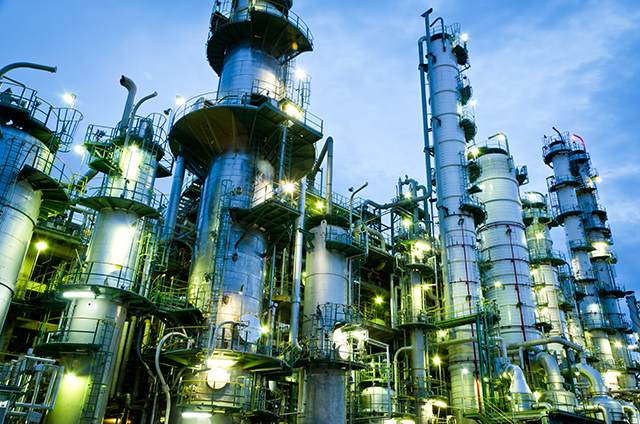Technology Overview
LC-Fining (Lummus Cities Service re-Fining) is a proprietary ebullated bed residue hydrocracking technology developed by Chevron Lummus Global (CLG), a joint venture between Chevron and Lummus Technology. Originally developed in the 1960s by Lummus Crest and Cities Service Research and Development Company for upgrading bitumen from tar sands, LC-Fining has evolved into a comprehensive residue ydrocracking technologies.
The technology is specifically designed to hydrocrack heavy vacuum residue feeds to lighter distillates while simultaneously removing sulfur, nitrogen, micro-carbon residue (MCRT), and metals containing species. LC-Fining provides high conversion of residues selectively to liquid products with superior performance in terms of ease, safety, and reliability.
Ebullated Bed Reactor Technology
Reactor Design and Operation
The core feature of LC-Fining technology is the ebullated bed reactor, which utilizes a three-phase system (liquid, vapor, and catalyst) to achieve optimal mixing and temperature control. Key characteristics include:
Physical Configuration:
- Upflow reactor design with low pressure drop
- 0.8-mm diameter extrudate catalyst held in fluidized state
- Catalyst bed expanded approximately 40% above its settled bed level through recirculating oil collected at the top of the reactor via a reactor ebullating pump
- Recirculated oil separated from the reactor effluent vapor by means of a recycle disengagement pan
- Recirculated oil flows through a downcomer pipe to the ebullating pump, which discharges it into the bottom plenum of the reactor, where it mixes with the Incoming reactor feed oil and hydrogen
- Mixture flows up through the primary distribution grid expanding the catalyst bed
- Due to the high degree of back mixing, the reactor essentially operates at isothermal conditions with only a slight axial temperature gradient
- By expanding the catalyst bed, catalyst can be added and withdrawn on-stream allowing the unit to operate for extended periods between turnarounds.
Figure 1 - LC-FINING Ebullated Bed Residue Hydrocracking Technology Platform[8]

Operating Conditions:
- Reactor temperature: 400-440°C (750-825°F)
- Reactor pressure: 100-200 atm (1500-3000 psig)
- Hydrogen partial pressure: 70-170 atm (1100-2500 psia)
- Conversion range: 40-90% (525°C+ basis)
Reactor Environment and Control:
The ebullated bed creates a continuous stirred tank reactor (CSTR) environment, resulting in:
- Near-isothermal operation with only slight axial temperature gradient
- Excellent temperature control and heat distribution
- Low and constant pressure drop due to fluid bed characteristics
- Superior mixing of liquid and catalyst particles
Temperature and catalyst level monitoring is achieved through:
- Radioactive density detectors for catalyst level control
- Internal and skin thermocouples for temperature monitoring
- Distributed Control System (DCS) with automatic cutback actions
Advanced Process Enhancements
Inter-Reactor Separator Technology:
First commercialized in 2003, this enhancement enables:
- Independent hydrogen management between reactor stages
- Increased train capacities from 25-30 kBPSD to 60-65 kBPSD at high conversions
- Up to 100 kBPSD capacity for lower conversion applications
- Optimized hydrogen partial pressure in each reactor stage
Figure 2 - Simplified LC-Fining Configuration with Multiple Reactors[5]

Membrane Gas Purification:
Implemented since 2007, membrane technology provides:
- 30% reduction in treat gas rates while maintaining hydrogen partial pressure
- High recycle gas hydrogen purity for improved efficiency
- Lower hydrogen losses and compression requirements
- Energy efficient and highly reliable operation
Figure 3 - LC Fining Product Separation and Fractionnation System[5]

Integrated Hydroprocessing (IHT):
Close-coupled integration offers:
- 35-40% reduction in standalone hydrotreater investment
- Improved heat integration and energy efficiency
- Simplified fractionation system design
- 1 to 1.5 times LC-Fining capacity processing capability
Figure 4 - LC Fining with Integrated Hydrotreating[8]

Key Process Advantages
Operational Benefits
Continuous Catalyst Management:
- On-stream catalyst addition and withdrawal eliminates shutdown requirements for catalyst replacement
- Extended operating cycles of 3-4 years between turnarounds
- Adjustable catalyst addition rates to maintain product quality objectives
- Catalyst type changes possible without reactor shutdown
Feed Flexibility:
- Processes heavy, high metals, high CCR and asphaltene containing feeds
- Handles feeds with high levels of finely dispersed solids
- No risk of pressure drop build-up with difficult feedstocks
- Suitable for extra-heavy residue, bitumen, and vacuum residue feedstocks
Commercial Feed Processing Range:
LC-Fining technology has demonstrated commercial capability to process vacuum residue feeds with the following properties:
| Property |
Commercial Range |
| API Gravity |
3.2 - 8.5 |
| Sulfur, wt% |
2.3 - 6.0 |
| Nitrogen, wppm |
3000 - 6000 |
| CCR, wt% |
16 - 28 |
| nC7 Asphaltenes, wt% |
5.0 - 18.0 |
| Ni + V, wppm |
160 - 500 |
Operational Performance Metrics
Typical Conversion Performance:
- Desulfurization: 60-90%
- Demetallization: 70-92%
- CCR reduction: 40-70%
- Hydrogen consumption: 120-340 Nm³/m³ (700-2000 SCF/Bbl)
Product Yields and Quality:
- High liquid selectivity to transportation fuels
- Superior distillate quality suitable for further processing
- Low sediment unconverted oil suitable for fuel oil or coker feed
Commercial units consistently achieve:
- 94-95% on-stream factors, exceeding industry norms by 3-4%
- Design throughput and conversion within 40 days of startup
- Extended operation periods without fractionation system fouling
- Reliable performance across varying crude blends
LC-Fining Technology Variants
LC-MAX Process
Advanced flow scheme combining LC-Fining with solvent deasphalting (SDA):
- 90+ percent conversion capability on difficult feedstocks
- Two-stage processing: mild hydrocracking followed by DAO processing
- Reduced reactor volume and catalyst consumption
- Superior product stability and reduced fouling
Next-generation advancement utilizing dispersed slurry catalysts:
- Near 100% conversion of heavy oils/SDA tar
- 115% liquid yield achievement
- Advanced micron-sized catalysts recovered in the process
- Eliminates fouling concerns associated with other catalyst systems
LC-LSFO Application
Specialized configuration for IMO 2020 compliance:
- 0.5 wt% sulfur fuel oil production capability
- Minimum modification to existing LC-Fining units
- Integrated hydrotreating for enhanced desulfurization
Technology Integration Applications
Coking Integration
LC-Fining combined with delayed coking provides:
- 88-90% overall conversion levels
- Higher liquid yields and improved hydrogen utilization
- Higher quality coke production (anode grade)
- Enhanced feed flexibility for difficult crude processing
Figure 5 - LC Fining with Coking Integration[5]

FCC Integration
Mild hydrocracking pretreatment for FCC feeds offers:
- Metals removal to protect FCC catalysts
- Residual carbon reduction for improved FCC performance
- Enhanced light products yields (naphtha, LPG, olefins)
- Improved operational flexibility
Petrochemical Integration
LC-Fining supports crude-to-chemicals strategies by:
- High-quality naphtha production for steam cracking
- Improved olefins yields in integrated configurations
- Enhanced refinery-petrochemical integration
- Maximized value addition from processed crude oil
Economic Performance
Economic Advantages
As claimed by the technolgy licensor:
- Lower investment costs compared to alternative technologies
- Lower capital investment through integrated designs
- Lower operating expenses via extended cycle lengths and through reduced maintenance requirements
- More efficient heat recovery and hydrogen utilization
- Lower hydrogen losses compared to other processes
- 35-40% reduction in hydrotreater investment when integrated
Competitive Advantages
Compared to Fixed Bed Technologies:
- Extended cycle length (3-4 years vs. shorter fixed bed cycles)
- Superior feed flexibility for heavy/contaminated feeds
- Lower pressure drop and fouling resistance
Global Commercial Experience
Market Position
As of 2019, CLG LC-Fining technology represents:
- Over 460 kBPSD of licensed capacity worldwide
- 240 kBPSD commissioned in the 9 years preceding 2019 (i.e. since 2010)
- Preeminent vacuum residue hydrocracking process globally
- Multiple large units commissioned in recent years
Table 1 - Licensed CLG Residue Hydrocracking Units as of 2018[3]

References
- M. Baldassari et al.. AFPM Annual Meeting Mar 2012. AM-12-73: LC‐MAX and Other LC‐FINING Process Enhancements to Extend Conversion and On‐Stream Factor. Retrieved via SCRIBD.
- Chevron Lummus Global. Bottom of the Barrel Upgrading: LC-Fining / LC-Max
- Ujjal Mukherjee and Dan Gillis. Recent developments in ebullated bed hydrocracking technology target high residue conversion and high quality products. PTQ Q1 2018. Chevron Lummus uploads.
- Dan Gillis. Residue Hydrocracking Solutions For Refinery Sustainability. RefComm Galveston April 29 - May 3, 2019.
- Dan Gillis. 2019. Residue Hydrocracking Solutions for Refinery Sustainability. Article adapted from Ref. 4.
- Wikipedia. Ebullated Bed Reactor.
- Chevron Lummus Global. Clean Fuels: Isocracking.
- Jan Steegstra. 2019. High Conversion of Vacuum Residue - Opportunities and Challenges. American Institute of Chemical Engineeers. Netherlands / Belgium Section.
- M.W. Da Silva. Jun 10, 2021. The Hydrocracking Technologies as Competitive Advantage in the New Downstream Industry. Linkedin.
- M.W. Da Silva. Jul 17, 2024. The Hydrocracking Processing Units as Competitive Advantage among the Downstream Players. Linkedin.
- S. Kandasamy, U. Mukherjee and M. Baldassari. Jul 23, 2008. Thermodynamic model of sediment deposition in the LC-FINING process. Energ. Fuel, Vol. 22. DOI 10.1021/ef800264e.

















